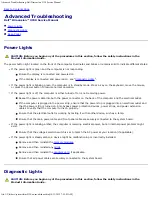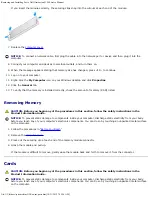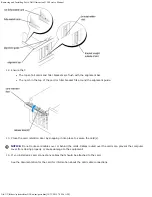
System Setup: Dell Dimension 9150 Service Manual
file:///T|/htdocs/systems/dim9150/en/sm/syssetup.htm[10/31/2012 7:59:07 AM]
Scroll up and down the list with the up- and down-arrow keys. As an option is
highlighted, the
Option Field
displays more information about that option and the
option's current and available settings. By pressing <Enter> or the left and right
arrow keys, you can toggle between a primary topic (collapsed) and subtopics
(expanded).
Key Functions
— This field appears
below the
Option Field
and lists
keys and their functions within the
active system setup field.
System Setup Options
NOTE:
Depending on your computer and installed devices, the items listed in this section may not appear, or may not
appear exactly as listed.
System
System Info
Displays the
System
name,
BIOS Version
number,
Service Tag, Express Service Code
, and
Asset
Tag
.
NOTE:
The system name listed in the BIOS may not appear exactly as the name that appears on the
computer or in the computer's documentation.
Processor Info
Displays the following information for the processor installed in the system:
Processor Type
,
Processor
Clock Speed
,
Processor Bus Speed
,
Processor Cache
Size
, Processor ID
number, whether the
processor is
Hyperthreading
or
Multiple Core Capable
, and if the processor has
64-bit Technology
.
Memory Info
Displays the amount of
Installed Memory
,
Memory Speed
,
Memory Channel Mode
, and a
description of the
Memory Technology
. This option also displays a table that describes the memory
size, whether the memory module is ECC capable, single or dual rank, type, and organization.
PCI Info
Displays the contents of each PCI slot.
Date/Time
Controls the system's internal calendar and clock.
Boot Sequence
Determines the order in which the system searches for boot devices during system startup.
NOTE:
If you insert a boot device and restart the computer, this option appears in the system setup
menu. To boot from a USB memory device, select the USB device and move it so it becomes the first
device in the list.
Drives
Diskette
Drive
Enables and disables the floppy drives and sets read permission for the internal floppy drive.
Off
disables
all floppy drives.
USB
enables the USB floppy drive.
Internal
(the default setting) enables the internal
floppy drive.
Read Only
enables the internal drive controller and allows the internal floppy drive read-
only permission.
NOTE:
Operating systems with USB support will recognize USB floppy drives regardless of this setting.
SATA Drives 0
through 3
Enables or disables a SATA device (such as a hard-drive).
On
(the default setting) enables the interface
so that the device can be used.
Displays the
Controller
type (
SATA
),
Port
number the drive is using,
Drive ID
number,
Capacity
,
Link
Speed
, and whether the drive is controlled by the
BIOS
.
PATA Drives 0
through 1
Enables or disables an ATA device (such as a CD or DVD drive).
On
(the default setting) enables the
interface so that the device can be used.
Displays the
Controller
type (
ATA
),
Port
number the drive is using,
Drive ID
number,
Capacity
,
Link
Speed
, and whether the drive is controlled by the
BIOS
.






























